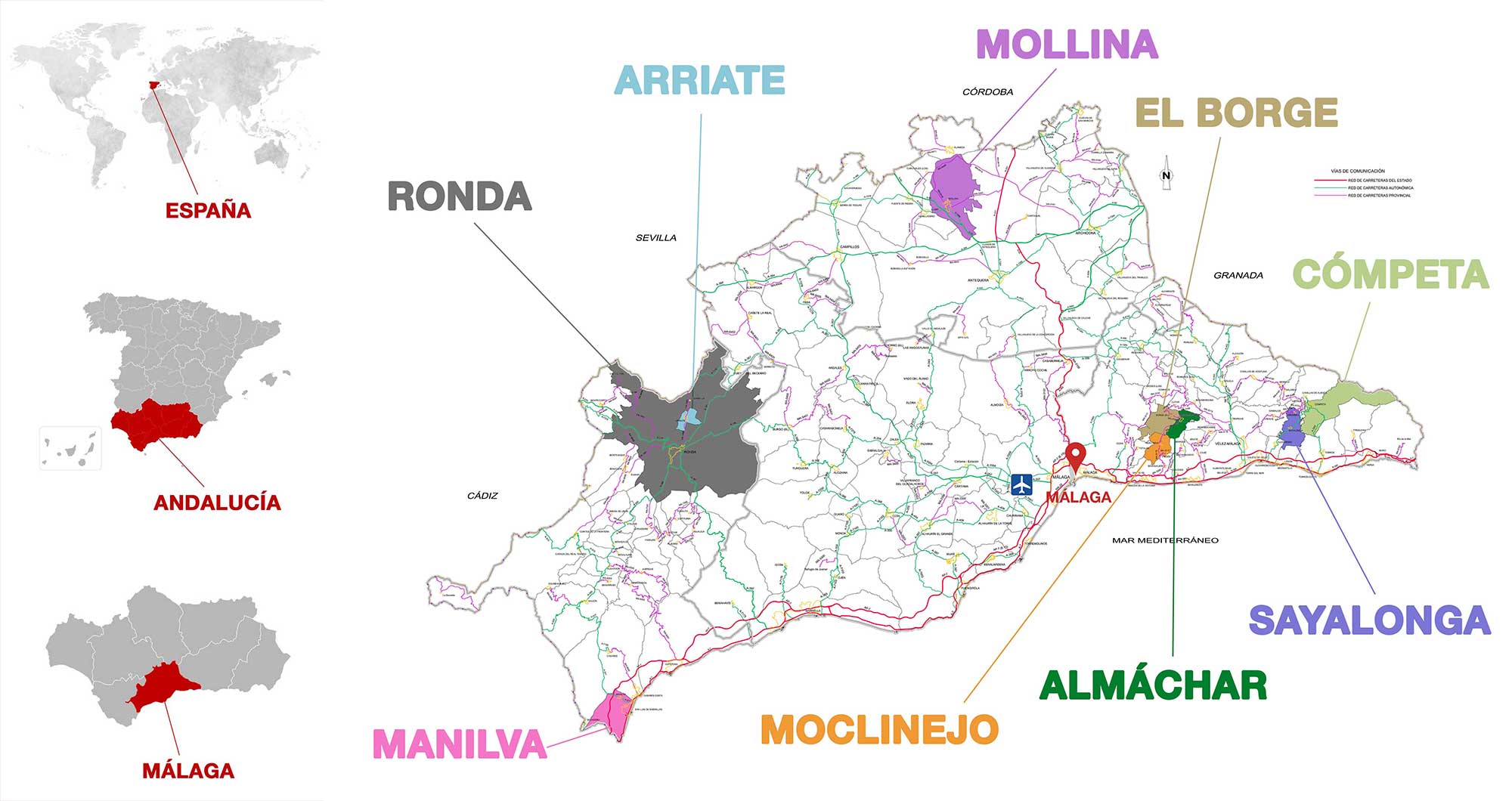As they are
The Ronda and Málaga Wine Route is home to the Protected Designations of Origin of “Málaga”, “Sierras de Málaga” and “Pasas de Málaga”. Located in the province of Malaga and made up of different subzones and wine production areas.
The potential of the mosaic of territories that make up the route is more than notable. Wines with history, whose origins date back to the Phoenician and Roman times and a historical, cultural and natural heritage of exceptional value.
All this, together with the diverse tourist and leisure offering that the destination offers, provides the visitor with an unparalleled experience.
Each Denomination of Origin protects different wines, thus, within the “Málaga” Protected Denomination of Origin we find: Still Wines, Sweet and Dry Wines, and Liqueur Wines.
In the Protected Designation of Origin “Sierras de Málaga” we find: Whites, Rosés, Reds and Sweet Reds. Within this protected designation of origin we find a subzone called “Serranía de Ronda” and six productive areas.
DESIGNATION OF ORIGIN SIERRAS DE MÁLAGA
What is the production area of Sierras de Málaga wines?
The production area of the D.O.P. Sierras de Málaga includes all the municipalities of the province of Málaga plus 2 municipalities of the province of Córdoba, these are: Benamejí and Palenciana.
Within this production zone a Subzone is distinguished; The “Serranía de Ronda” and 6 productive areas: “Axarquía”, “Montes de Málaga”, “Manilva”, “West Coast”, “North of Málaga” and “Sierra de las Nieves”.
What wines can bear the name Serranía de Ronda?
What grape varieties are Sierras de Málaga wines made with?
What wines are covered by the D.O. Sierras of Malaga?
The D.O. Sierras de Málaga protects “quiet” wines, with an alcohol content of between 10 and 15.5% alc and a sugar content of less than 12 gr/l. They are classified as white, red and rosé.
Whites: vol. graduation 15.5.
Rose: vol. graduation 15.5.
Reds: vol. graduation 15.5.
Sweet Reds from overripe grapes: with an alcohol content between 12 and 15.5% Vol. and a sugar content ≥ 45 gr/l
Depending on their aging, they will be called:
Aging: Minimum aging of 2 years, 6 months of them in oak barrels.
Reserve: Minimum aging of 3 years, 12 months of them in oak barrels.
Gran Reserva: Minimum aging of 5 years, 24 months of them in oak barrels and 36 months in bottle.
Gran Reserva of Whites and Rosés: minimum aging of 5 years, of which at least 6 months in oak barrels.
DESIGNATION OF ORIGIN MALAGA

What is the Malaga wine production area?
What grape varieties are Malaga wines made with?
How are Malaga wines made?
Sweets.
From overripe grapes, among which are naturally sweet wines.
From raisined grapes.
Dry. With an acquired alcoholic degree ≥ 15.
Like liqueur wines. They result from adding wine alcohol to the must, during fermentation or at the beginning of it, in order to stop it, and according to this technique they can finally be dry, semi-dry, semi-sweet or sweet.
How are sweet liqueur wines made?
Natural sweet wine: It is obtained from fresh grape musts. The fermentation is stopped with the addition of wine alcohol.
Master Wine: It is obtained from fresh grape musts to which wine alcohol is added before fermentation begins, but in such an amount that it allows it to be very slow and incomplete, leaving the wine sweet.
Tender Wine: It comes from grapes that have been exposed to the sun for a long time, resulting in musts with a high sugar content. The fermentation is stopped with the addition of wine alcohol.
What terms are used to understand the aging of Malaga wines?
«Pale», with an aging of up to 6 months.
«Noble», 2 to 3 years.
«Añejo», from 3 to 5 years.
“Trasañejo”, over 5 years old.
Málaga Wines… why are some dark if they are made from white grapes?
- Because they are wines with oxidative aging. The more aging, darker.
- Because some Málaga can be added arrope.
What is arrope?
“Dorado or Golden”, without arrope. The color is provided by aging; they are wines that range from golden to amber in color.
«Red gold or Rot gold», with the addition of up to 5% of syrup, are wines that range from amber to dark amber, with reddish-golden reflections.
“Oscuro or Brown”, with the addition of between 5 and 10% arrope, are wines that range from dark amber to dark mahogany.
«Color», with the addition of between 10 and 15% arrope, are wines that range from dark mahogany to ebony.
“Black or Dunkel”, more than 15% of cloth with color from ebony to black.
Certain wines can receive complementary names depending on their production and organoleptic characteristics: Dry wines can be called Dry Pale or Pale Dry.
The sweets can be named with the aforementioned Naturally Sweet, Dulce Natural, Tender and Maestro, or with the terms Dulce Crema or Cream, Pale Cream and Sweet.
What is a Pajarete?
What is a Lágrima wine?
And a Lacrimae Christi wine?
Match or assemble?
DESIGNATION OF ORIGIN MÁLAGA RAISINS
The Designation of Origin Malaga raisins covers raisins obtained by sun-drying ripe fruits of the Moscatel de Málaga or Moscatel de Alejandría variety, harvested and dried in the Axarquía region or in the Manilva subzone.
Natural drying in the sun is traditional in the area and the only one allowed by the Regulation, so that our product maintains organoleptic characteristics that make it unmatched in flavor, texture and color.
Drying is carried out on the steps, which are surfaces where the grapes are spread for raisining, oriented towards midday, with a minimum inclination of 8%, provided with an awning and support to avoid rain and dew. Its size depends on the availability of the land, with dimensions around 10-12 m x 4-5.5 m, with an approximate capacity between 300 and 400 kg. per passerby
The grape clusters are carefully arranged on the surface of the rack: The smallest berries are left in the outermost areas, since they are the first to dry, remaining on the racks for approximately 10 days, varying according to weather conditions.
The bunches, once dried, can be shelled manually, through the work known as “chopping”, or mechanically in industries. All members of the family participate in chopping, although it is carried out mainly by women, with scissors of a size and shape adapted to the dried bunches so as not to deteriorate the quality of the shelled fruit. Therefore, raisins with Designation of Origin have two basic forms of presentation, in bunches or grains.

Product description
Chemical characteristics:
The humidity level of the grain raisins will be less than 35%. In the case of bunches, it is limited to 30%, since we must consider the dry matter provided by the rachis.
The sugar content will be greater than 50% w/w.
Acidity, between 1.2 and 1.7% in tartaric acid.
pH, between 3.5-4.5.
Solids soluble in water, greater than 65ºBrix.
Organoleptic characteristics:
Large size, clearly distinguishable from other products in its class such as sultanas or Corinto. To preserve this uniqueness, in the grain presentation a maximum of 80 fruits are allowed per 100 grams of product.
Color, uniform violet black, characteristic of natural drying in the sun, compared to the reddish or light coloring typical of early harvests or artificial drying.
The shape, rounded.
The fruit may have a peduncle when shelling is manual.
The muscat flavor of the grape from which it originates persists in the raisins, which is reinforced by an intense nasal aroma.
Acidity, to the degree described above, contributes to a particular acid-sweet balance.
Skin Consistency: Since the raisin comes from a berry that has not received any skin-degrading treatment, raisins have a skin of medium consistency.
Linked to its medium size, the degree of humidity and characteristic Brix, the raisin has an elastic and flexible touch, and its pulp results in a fleshy and juicy mouthfeel, tactile sensations that are opposed to the dry and inelastic ones expected in dried fruits.
